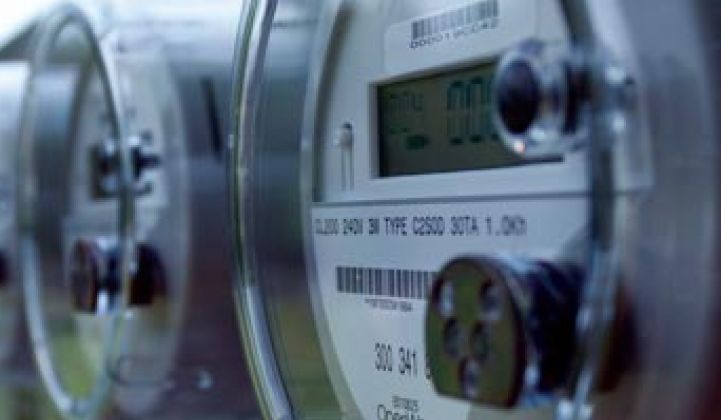Back in 2013, Massachusetts ordered its utilities to create comprehensive 10-year grid modernization plans, ones that require their smart meter deployments to do a lot more than automated meter reading. This week, utility National Grid announced that it has tapped long-time partner Itron as its provider of choice for this wide-ranging effort.
Tuesday’s announcement represents the second-biggest U.S. advanced metering infrastructure (AMI) project so far this year, after New York utility Consolidated Edison’s $1.3 billion smart meter rollout with Silver Spring Networks and Aclara.
It’s also an important win for the Liberty Lake, Wash.-based company and its OpenWay technology, which over the past few years has been updated to turn smart meters into distributed communications and computing nodes to serve multiple grid tasks.
The deal isn’t final yet, however, and the scale of the deployment is still being considered. National Grid is still awaiting approval of its grid modernization plan from the Massachusetts Department of Public Utilities (DPU), which is expected to come later this year.
The options it’s submitted for approval range from a full rollout to every customer, to limiting smart meters only to those customers that opt in to the service. The utility, which serves about 2 million electricity and gas customers in the state, submitted a set of four options in August 2015, and filed a revised version of those plans last month (PDF).
Taken as a whole, National Grid’s 10-year modernization plans could cost as little as $524 million for the “opt-in” version to $1.275 billion for its “balanced” plan, which includes an equal focus on smart meters and smart grid investments. Its options also include two other scenarios that focus either on smart meters or grid investments.
National Grid’s five-year smart meter rollout costs, in turn, could range from $238 million for the opt-in plan to $792 million for the balanced plan, according to last month’s filing. Costs for the smart meter and grid-focused options would stand at $619 million and $584 million, respectively.
Unlike many of the smart meter and smart grid projects from years past, National Grid’s proposals will rely on its smart meters to support a long list of smart grid capabilities. According to its June filing, these include “(1) reducing the effects of outages; (2) optimizing demand, including reducing system and customer costs; (3) integrating distributed resources; and (4) improving workforce and asset management.”
The DPU has coined a new term, advanced metering functionality (AMF), to describe what the state’s utilities must do with their smart meters. This definition includes “(1) the collection of customers’ interval usage data, in near real time, usable for settlement in the ISO-NE energy and ancillary services markets; (2) automated outage restoration and notification; (3) two-way communication between customers and the electric distribution company; and (4) with a customer’s permission, communication with and control of appliances.”
These are a far more comprehensive set of capabilities than those supported by previous generations of smart meters. But ongoing improvements and falling costs for computing and communications technologies have allowed smart meter vendors like Itron, Silver Spring and Landis+Gyr to develop technology that can support them.
At the same time, states like Massachusetts and New York are demanding these capabilities from future smart meter deployments, to support the integration of distributed energy resources (DERs) and distribution automation (DA) technologies, as well as provide customers the information they’ll require to become more active players on the edge of the grid. (Con Ed’s smart meter plans are a good example of the more rigorous requirements being placed on smart meters, as part of New York’s Reforming the Energy Vision initiative.)
“This is a really broad list of what they want to accomplish -- and they’re flexing almost every aspect of what they want a grid modernization program to do,” Sharelynn Moore, Itron’s vice president of corporate marketing and public affairs, said in a Wednesday interview.
National Grid’s selection of Itron wasn’t too much of a surprise, given that the two have been working together for years in Worcester, Mass. to prove out these capabilities across a 15,000-customer pilot project. “They’ve had a really well-managed and comprehensive pilot in Worcester that gives them an understanding of what their capabilities are,” she said.
As part of that pilot, Itron partnered with startup Ceiva to test a variety of home energy data displays, smart thermostats and load control devices with about 4,500 test customers. National Grid’s proposals also include a role for Ceiva to extend this capability to customers across its service territory, Moore said.
GTM Research's latest report, Utility AMI Analytics at the Grid Edge: Strategies, Markets and Forecasts, notes that after a multi-year slowdown in smart meter deployments across the United States, new regulatory mandates and revenue opportunities associated with DERs are reinvigorating growth in the sector. Much of this growth is being driven by new use cases beyond the initial meter-to-cash models of deployments past. Rollouts like those being proposed by National Grid, Con Ed and others offer real-world examples of this trend.




